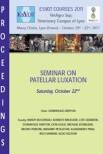This report aims to describe implant characteristics and procedure for implantation, and comment on and report the clinical outcomes in small dogs and cats using the new Zurich mini cementless total hip system.
This study involved 8 cats and 42 dogs, with 3 cats and 6 dogs having bilateral total hip arthroplasties (THA). The mean body weight for cats was 6.5 kg, and the mean body weight for dogs was 9.2 kg. In the group of THAs in cats, capital physeal fracture was the reason for performing a THA in six cases (60%), hip dysplasia was the underlying reason in four cases (30%) and hip luxation in one case (10%). Among the 48 THAs in dogs, hip dysplasia was the underlying cause for performing THA in 27 cases (56%), avascular necrosis of the femoral head in 12 cases (25%), traumatic luxation with underlying hip dysplasia in 4 cases (8.5%), capital physeal fracture in 4 cases (8.5%), and traumatic femoral head fracture in 1 adult dog (2%).
Seven postoperative complications were encountered, and all were solved without the need for explanting the prosthesis, except in one case because of the owner's decision.
In conclusion, the Zurich mini cementless total hip system performed well in this study, with most dogs and cats having an excellent outcome and no patient being too small for the available implant sizes.









